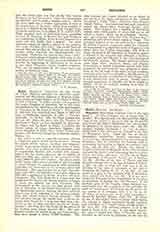

Benin, Vicariate Apostolic of THE COAST OF (ORAE BENINI), includes an extensive negro country and the former kingdom of Western Equatorial Africa, in Upper Guinea, on the Bight of Benin, or Gulf of Guinea. In 1860 a mission was founded in the former Kingdom of Dahomey, but as this name was disliked by the inhabitants the title was changed to “Vicariate of the Coast of Benin”. The mission of Dahomey was separated from Benin in 1882 and made a Prefecture Apostolic, in 1901 a Vicariate Apostolic. On May 10, 1894, the Niger mission was also cut off. Since the latter date the Vicariate of the Coast of Benin has been bounded by Dahomey, the Niger, and the Bight of Benin; it includes the British colony of Lagos (Southern Nigeria), the native Kingdom of Porto Novo (under French protection), and the native kingdoms of Yoruba, Isebou, Ibadan, etc.
The region is rich in vegetable resources. Cotton is indigenous and is woven by the women. Among the pagan blacks human sacrifices are frequent; cruelty in atrocious forms is characteristic of these natives. The coast is indented with estuaries, some of considerable breadth and studded with islands. Behind the flat shores plateaux rise to heights of 2000 and 3000 feet. There is an extensive traffic in salt, palm oil, and other staples. The area is about 55,985 square miles, about one-half of which belongs to Great Britain; the population in 1901 numbered 1,500,000, and there were in the territory about 308 Europeans. The appointment of a vicar Apostolic dates from 1891; the residence is at Lagos, which in 1901 had a population of 41,847, of whom 233 were Europeans. The vicar Apostolic is chosen from the members of the Society for African missions of Lyons to whom the mission has been entrusted. The development of this mission has been greater than that of Dahomey, as the British Government grants the missionaries greater freedom for their spiritual labors and gives subsidies to the mission schools when this course furthers British interests. The first converts among the blacks were ex-slaves returned from Brazil; for a long time they were catechized by one of their own race, known as “Padre Antonio”, who kept alive the Faith till the arrival of the Fathers from Lyons (Louvet, 291). The missionaries number 26 regular clergy and 1 lay brother; they have charge of about 15,500 Catholics. The chief stations are: Lagos, situated on an island at the mouth of the Ogun, and known as the “African Liverpool”, Titolo, Tocpo, Abeokuta, Oyo, Ibadan, Ishure, Ibowon. Less important and more irregularly served are Eboute-Meta, Bada-gri, Iboake, Awe, Ishwo. The vicariate has a number of flourishing schools with 2,059 pupils, of whom 800 are in the school at Lagos. There are 25 catechists. Orphan-ages and hospitals have also been founded, and a promising agricultural school exists at Tocpo. The principal hospital is the one conducted at Abeokuta by Father Coquard, commonly called Dr. Coquard; he is consulted as a physician as far as Lagos, a town where there are English physicians. The King of Aque, the head of the federation of Abeokuta, grants a subsidy to the hospital and, although a heathen, is present with his followers at the chief festivals of the Catholic mission. The mission territory includes three large cities: Abeokuta, Ilorin, and Ibadan. Constrained to defend themselves against raids from Dahomey, the native blacks have gathered in Abeokuta, on the left bank of the Ogun, in large numbers, variously estimated from 150,000 to 200,000, and have surrounded the city, or collection of 140 villages, with a wall twenty-four miles in circuit. Ibadan has a reputed population of 150,000 and Ilorin 60,000 to 80,000. As yet no Catholic missions have been established in them.
ALBERT BATTANDIER

